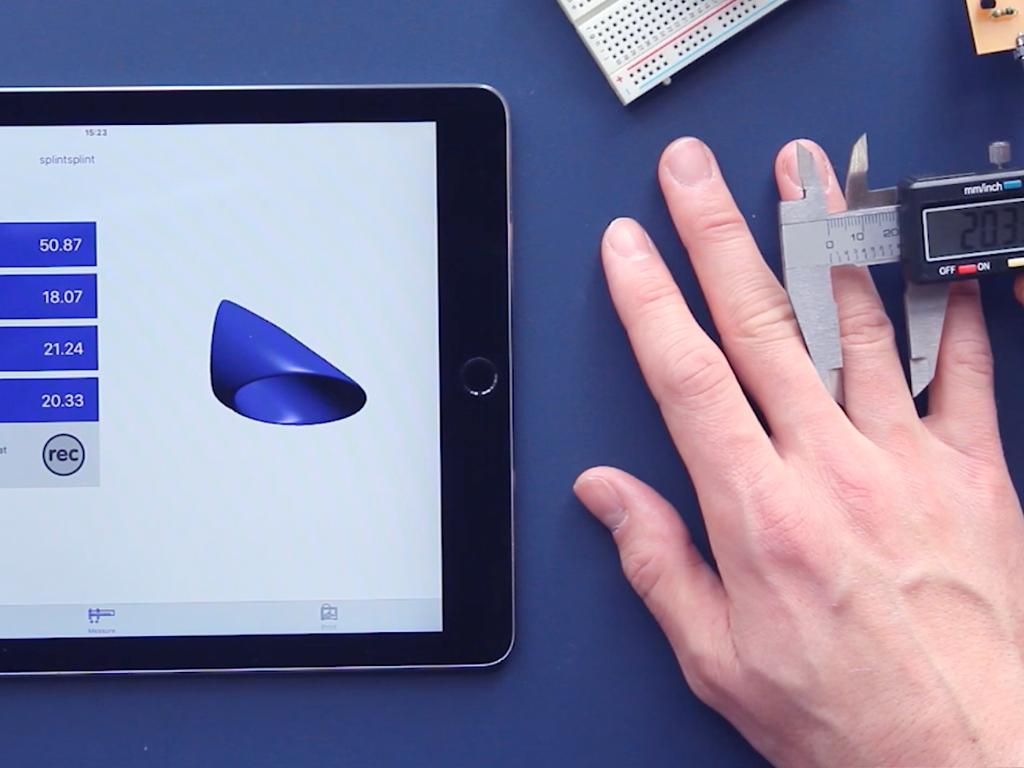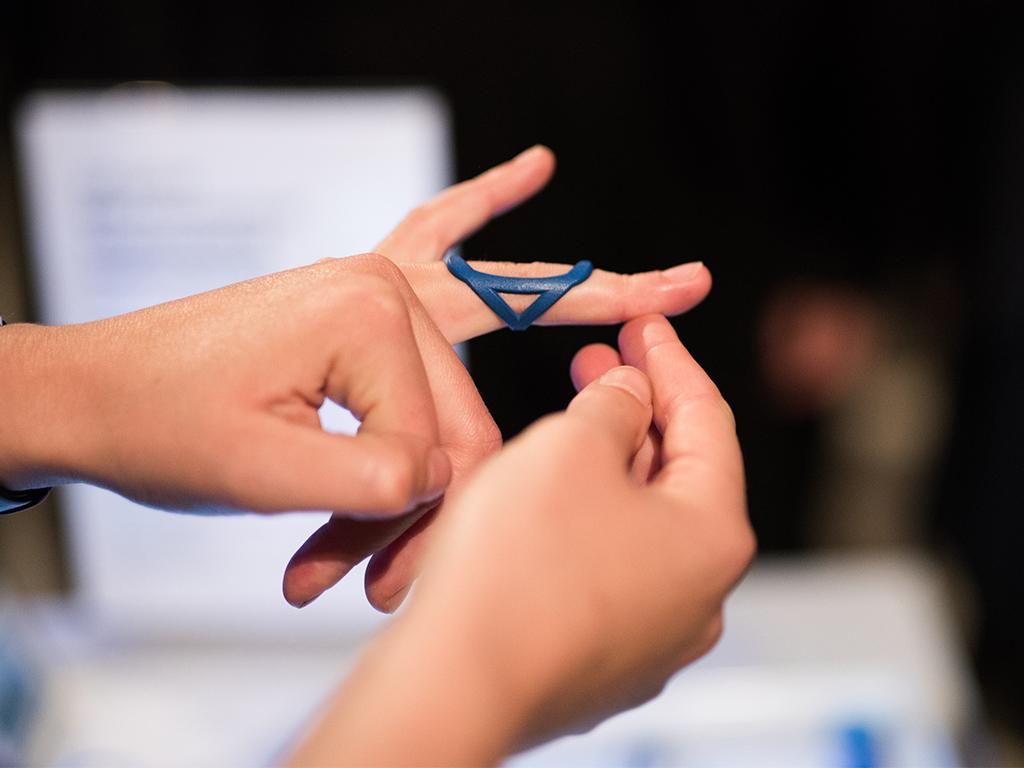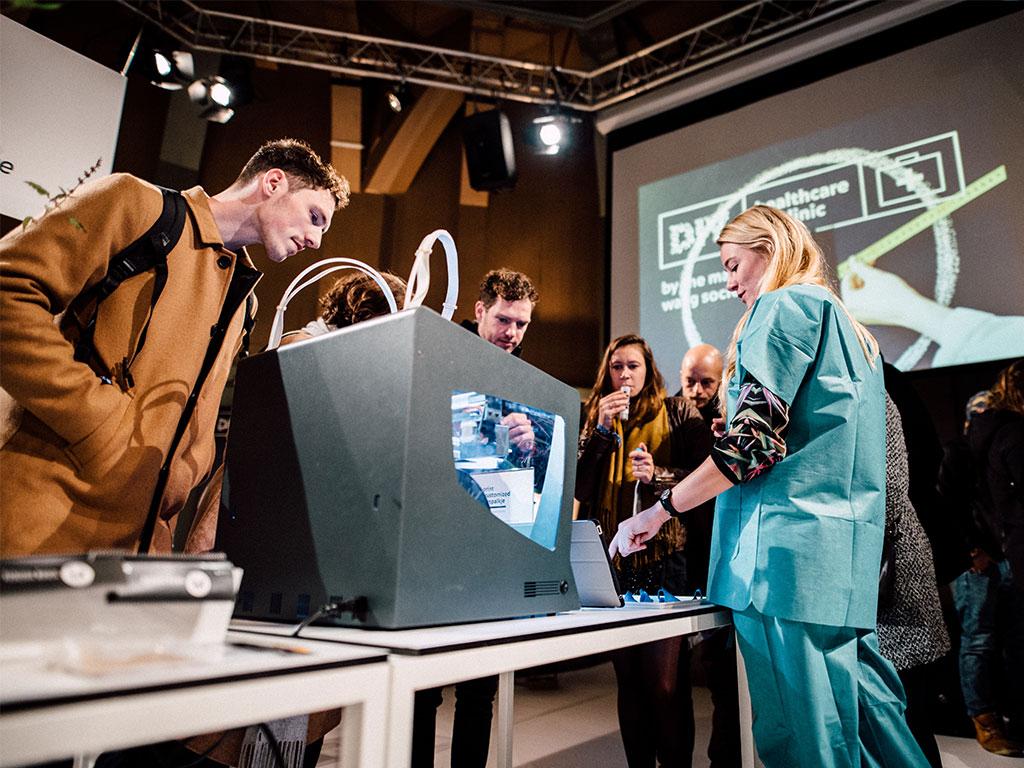A product with potential for clinical practice?
In the context of MakeHealth - a programme that explores a crossover between Healthcare and the ‘Do It Yourself’ makers culture of Fab Lab –software developer Taco van Dijk and designer Mickael Boulay developed a working demo of an app on a tablet to generate a ready to-be-3D-printed finger splint. This parametric design application seemed like a potential breakthrough, but it was still unclear where such a medical product has to meet for a market introduction.
From her ambition to explore the potential of new technologies for the development of healthcare products, Ida Poortinga - Master student Biomedical Engineering at the University of Groningen - came to the Waag and was enthusiastic to take up this issue. In this blogpost Ida will explain her graduation project “Local fabrication of a custom-fit finger splint, using parametric design and additive manufacturing”.
Personal note
At first, I was inspired by the many beautiful 3D printed orthoses provided by various artists and designers. During my survey interviews with hand therapists, the idea of having a 3D printer in the healthcare clinic was received with great enthusiasm. I wondered why this promising technique and the accompanied beautiful orthotic designs did not find its way to the clinic of the hand therapist yet. From this moment I was suddenly more interested in the question “What happens when such a new technology meets the traditional pathways of medical product development and the pertaining market?”. I decided to not only focus on the design assignment, necessary to meet the graduation requirement, but to use this design assignment as a case study for this question surrounding it. My goal was to provide insights in the entire process – from the creation until wearing the device – so that the final product can be offered in the current market of medical devices. In this way I not only hope to present a revolutionary product, but also provide insight into how such a new manufacturing technique can find its position in the strict market wherein medical devices are provided.
Introduction
The rise of digital fabrication and the Maker Movement has enabled people to start playing an active role in devising and developing their own medical devices. The benefit of digital fabrication for healthcare is its ability to rapidly alter size and shape of orthoses to meet specific patient sizes and needs. In addition, digital fabrication offers an on-demand supply chain that potentially increases sustainability of the medical device industry. Therefore, the popularity of digital fabrication in orthoses design is clearly present, yet little can be found to actually be used in a clinical setting. The traditional medical device industry is strictly regulated to enable patient access to high quality, safe and effective medical devices, and restricting access to those products that are unsafe or have limited clinical use. Therefore, clarification is therefore needed to point out whether it is feasible to locally 3D print a customized orthosis that can be considered safe and effective.
Method
The study aims to revisit medical product development in the context of the aforementioned rise of additive manufacturing and the Maker Movement. Therefore, the following research question was addressed: “Can digital fabrication enable patient access to local fabrication of customized orthoses with the quality and safety of professionally-graded medical devices?” Quality and safety is hereby approached with reference to the European regulatory rules and guidelines for medical devices. The research question is addressed by means of the design specific case study of the customizable finger splint. The first part of the study aims to reveal the challenges that might limit a successful introduction in a clinical setting. The second part of the study, the design case, aims to provide one specific solution that confirms the feasibility of locally 3D printing a customized finger splint.
Results
The first part of the study revealed that still many challenges need to be overcome for a successful clinical application. At first, the current regulatory system does not seem suitable for local fabrication of personalized medical devices. Second, it revealed that the underlying technique of additive manufacturing limits material options and negatively affects the quality and mechanical safety of the printed object. Third, it demonstrated that the access to digital fabrication is still restricted to people with 3D modelling skills and knowledge of additive manufacturing. The second part of the study, the development of the finger splint, made clear that these challenges can be tackled. The provided solution is the application that enables the hand therapist or patient to 3D print a customized finger splint, without need the for 3D modelling skills ór knowledge of additive manufacturing. This was enable by the coupling the parametric design software to a ISO-certified 3D printing service.
Conclusion
From this it was concluded that digital fabrication can be guided to enable patient access to local fabrication of 3D printed orthoses with the quality and safety of professionally-graded medical devices. In addition, the application offers patients the opportunity to order a personalized finger splint from the comfort of their own home. This solution even creates higher quality splints then current methods to create a custom-fit. Therewith, the provided solution contributes to a more effective treatment. This on-demand production technique that addresses the personal needs of a specific patient contributes to more affordable and qualitative healthcare.
Discussion
Drawbacks of the provided solution are fabrication- and delivery time resulting from the selected manufacturing process. Contrary to expectations, the technology and healthcare system is not yet ready for time-efficient and high-quality fabrication closer to the patient. Future research should be focussed on the development of 3D printers suitable for implementation within the clinic of the hand therapist. A second drawback is that the design freedom is limited by the parametric input. In order to allow automated modelling of more complex orthoses, parametric design software should be further developed with the aim of orthoses design.
Recommendations
Now that the possibilities of parametric design and additive manufacturing are approved to be successful for the fabrication of orthoses, it is recommended to further develop the product for a market introduction. From a business perspective this 3D design application is not only of interest for orthoses design, but also for prostheses and implants. Marketing the parametric finger splint, would be an important step in the accomplishment of on-demand production and mass-customization in the context of healthcare.


